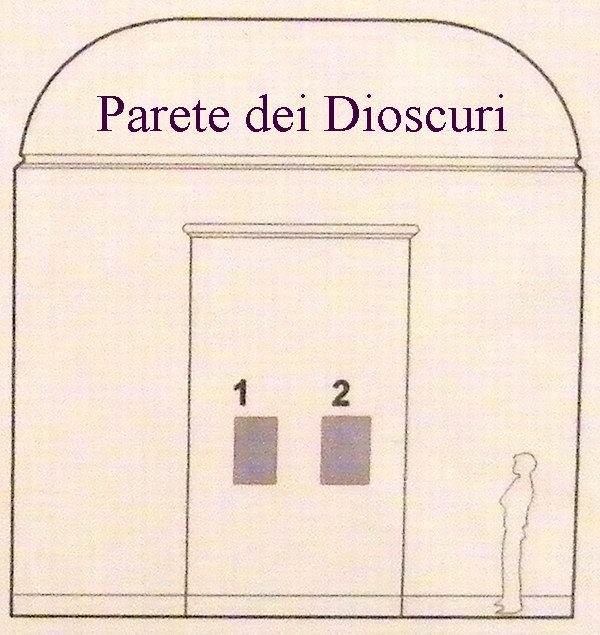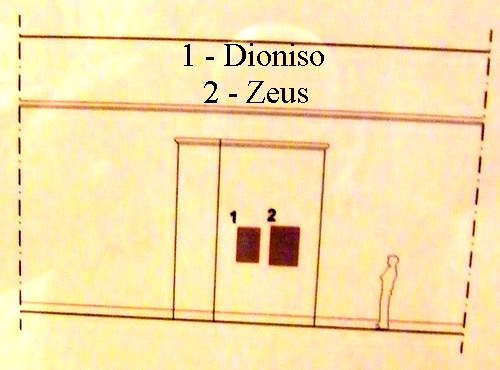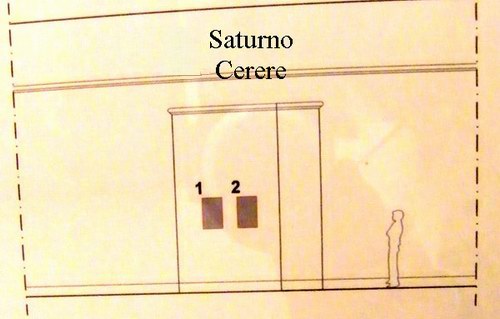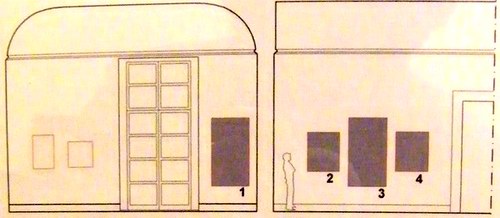Sala LXXII - La casa dei Dioscuri
Nella Casa dei Dioscuri, posta nell'Insula 9 della regio VI di Pompei e caratterizzata da una ricca decorazione di tardo IV stile, il visitatore era accolto sin dall'ingresso da grandi immagini di divinità che si stagliavano su di un omogeneo fondo rosso: tra queste colpisce la differenza nella qualità dell'esecuzione dei Dioscuri che si fronteggiavano sulle pareti del vestibolo. Accanto ai più comuni temi mitologici preferiti in quest'epoca (Endimione, Narciso), la decorazione di questa casa presenta soggetti più colti e di più difficile interpretazione, come i quadri con scene teatrali.
Nel tablino si stagliavano, entro una raffinata decorazione dal raro fondo azzurro, due quadri relativi ad Achille una figura eroica che, in diverse epoche, gode, seppur con accenti diversi, di grande fortuna nella decorazione delle case romane. In un quadro, è raffigurata l'ira dell'eroe che, protetto da Atena alle sue spalle, sguaina la spada contro Agamennone. In quello della parete antistante, è invece il momento fatale in cui Achille deve scegliere se restare nascosto in vesti femminili presso l'amata o andare incontro al suo destino eroico e tragico seguendo Ulisse, che lo ha scoperto con il noto stratagemma del suono delle trombe di guerra che risvegliano il suo impeto guerriero. Il livello delle pitture di questa casa risulta anche dalle vignette con Menade e Satiro in volo che affiancavano i quadri mitologici.
Ritagliato dal contesto originario nel quale comparivano anche altri elementi paesistici, ricostruibili dal disegno di A. Ala (1847) è il frammento che raffigura una vecchia contadina con capello di paglia sul capo che, seduta con il suo cane di fronte a una capanna, offre da bere a un viandante, e che ha acquistato vita autonoma, divenendo celeberrimo per la particolarità della scena interpretata anche come Edipo dinanzi alla Sfinge, o la consultazione di una fattucchiera.
The House of the Dioscuri
The House of the Dioscuri is located in Insula 9 of Region VI and is richly decorated with late Fourth Style paintings. Large depictions of these gods pointed on a homogeneous red background welcomed visitors at the entrance to the house. The Dioscuri faced each other on the walls of the vestibulum, but the difference in the quality of execution of the paintings is striking. In addition to the more common mythological themes popular in this period (Endymion, Narcissus), the decoration of this house includes subjects that are more cultured and difficult to interpret, such as the panel with theatrical scenes.
Decorating the tablinum on a fine and rare blue background were two paintings relating to Achilles. Achilles was a heroic figure frequently depicted in the decoration of Roman houses in different periods, albeit with different emphases. In one painting the hero's anger is illustrated; protected by Athena, he draws his sword against Agamemnon. In contrast, the painting on the opposite wall depicts the fatal moment in which Achilles must decided whether to remain hidden in women's clothes near his beloved or to meet his heroic and tragic destiny by following Ulysses. Ulysses had used a famous trick to discover Achilles -sounding the trumpets of war to awaken Achilles' warrior passions. The high quality of paintings in this house can also be seen in the vignettes with flying Maenads and Satyrs that flank the mythological panels.
A fragment depicts an old peasant wearing a straw hat, seated before a hut, offering a drink to a traveler. It was removed from its original setting which included other landscape elements - these con be reconstructed from a drawing by A, Ala (1847). The fragment has taken on a life of its own, becoming famous for the details of the scene, which has been interpreted as Oedipus before the Sphinx or as a consultation with a witch.
Clicca sui riquadri e visualizza l'opera. Click on the boxes and view the picture.




Sala LXXII
La decorazione della Casa di Meleagro
La Casa di Meleagro, che prende nome da un quadro ancora presente nel vestibolo, con la raffigurazione del giovane cacciatore accanto ad Atalanta, fu scoperta nella prima metà dell’Ottocento, nella porte settentrionale di Pompei, nell’insula 9 della regio VI caratterizzata dalla presenza di altre grandi case di prestigio, come quella del Centauro e quella dei Dioscuri.
La decorazione interna era stata rinnovata negli ultimi anni di vita della città, dopo il terremoto del 62 d.C., con grande dispiego di mezzi, raggiungendo un risultato di notevole effetto dovuto anche all’ampiezza dell’impianto architettonico della casa nel quale si distinguono un nucleo di stanze gravitante intorno all’atrio e immediatamente raggiungibile dalla strada, un altro con gli ambienti di ricevimento più importanti organizzato intorno all’ampio peristilio e raggiungibile solo attraverso percorsi “controllati” e un terzo con gli ambienti di servizio accessibili da un ingresso secondario.
Nel rinnovare la decorazione dipinta il proprietario mirò all’effetto piuttosto che alla qualità: già nel vestibolo, insolitamente largo, ci sono due quadri (lasciati sul posto], altri tre sono stati staccati dall’atrio (Teti ed Efesto, Didone abbandonata, e la Vestizione di un liricine) e due (Ares e Afrodite, Io e Argo) dal tablino che esibiva, nella parte alta delle pareti, una ridondante e complessa decorazione in stucco policromo. Ancora quadri nei cubicoli (tra i quali si sono conservati perché staccati: Ganimede.
Coppia su kline, Ermafrodito e Pan) e sotto i portici del peristilio. le lunghe pareti di fondo di quest’ultimo, presentano oggi le lacune lasciate dalla asportazione dei quadri di divinità, nei quali prevalgono i temi amorosi o legati al ciclo dionisiaco, eseguiti in una qualità molto mediocre (Lotta tra Eros e Pan, Imeneo, Arianna abbandonata, Teti su mostro marino, Apollo e Dafne): quelli rimasti in sito ci sono noti solo dalle incisioni ottocentesche. È evidente la scelta di temi idonei a creare nella casa un’atmosfera piacevole, lontana dal clima eroico della precedente età augustea.
Esemplare da questo punto di vista è il quadro con Arianna abbandonata: centro dell’attenzione non è più Teseo con le sue eroiche imprese ma la fanciulla dal bel corpo, riccamente abbigliata, che si sveglia in lacrime sulla spiaggia di Nasso, in compagnia di un amorino anch’esso piangente, mentre la personificazione delta vendetta, le indica in lontananza la nave in cui l’eroe è solo una sagoma tra le altre.
The decoration of the House of Meleager
The House of Meleager takes its name from a painting that can still be seen in the vestibule of the house and which depicts the young hunter next to Atalanta. The house was excavated in the first half of the 19th century in the northern part of Pompeii’ in Insula 9 of Region VI. Other large and prestigious houses, such as the House of the Centaur and the House of the Dioscuri, are found in this Region. The interior decoration of the house had been renewed in the last years of the city’s life, after the earthquake of AD 62, and no expense had been spared.
This had also had a notable impact on the spatial arrangement of the house. Three nuclei of rooms can be identified, one around the atrium and immediately accessible from the street, another of more important reception rooms arranged around the wide peristyle and accessible only through ‘controlled’ paths, and the third of service rooms reached from a secondary entrance. In the redecoration of the walls the owner of the house had aimed for effect rather than quality.
There were two paintings (left in situ) in the unusually wide vestibulum, another three (removed) in the atrium (Thetis and Hephaestus, Dido abandoned, and the Dressing of a lyre-player), and two in the tablinum (Ares and Aphrodite, Io and Argus) A lavish and complex decoration of polychrome stucco higher on the walls accompanied these paintings. Another four paintings were found in the cubicula (the following were preserved because they were removed: Ganymede, a Couple on a kline, Hermaphrodite and Pan) and in the portico of the peristyle.
Today holes can be seen in the long walls of the portico where paintings’ of the gods were removed. The prevailing themes of the paintings related either to love or to Dionysiac rites, but their quality was mediocre (Fight between Cupid and Pan, Hymenaeus. Ariadne abandoned, Thetis on a sea monster, Apollo and Daphne), The ones that were left in situ are now known only from 19th century engravings.
The chosen themes are clearly those appropriate for the creation of a pleasant atmosphere, for different from the heroic fashions of the previous Augustan age.
An example is the painting of Ariadne abandoned: the focus of the picture is no longer Theseus and his heroic deeds but the beautiful young girl, richly dressed, who awakens in rears on the beach of Naxos in the company of a cupid who is also crying. The personification of Revenge paints to the ships in which the hero is only one figure among many.
Clicca sui riquadri e visualizza l'opera. Click on the boxes and view the picture.

Fotografie di Giorgio Manusakis




